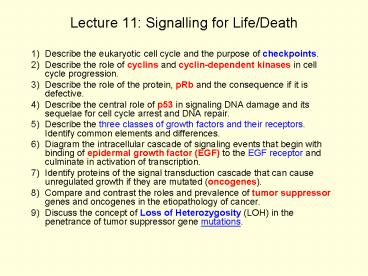Lecture 11: Signalling for LifeDeath - PowerPoint PPT Presentation
Title:
Lecture 11: Signalling for LifeDeath
Description:
Describe the role of cyclins and cyclin-dependent kinases in cell cycle progression. ... factor (EGF) to the EGF receptor and culminate in activation of transcription. ... – PowerPoint PPT presentation
Number of Views:42
Avg rating:3.0/5.0
Title: Lecture 11: Signalling for LifeDeath
1
Lecture 11 Signalling for Life/Death
- Describe the eukaryotic cell cycle and the
purpose of checkpoints. - Describe the role of cyclins and cyclin-dependent
kinases in cell cycle progression. - Describe the role of the protein, pRb and the
consequence if it is defective. - Describe the central role of p53 in signaling DNA
damage and its sequelae for cell cycle arrest and
DNA repair. - Describe the three classes of growth factors and
their receptors. Identify common elements and
differences. - Diagram the intracellular cascade of signaling
events that begin with binding of epidermal
growth factor (EGF) to the EGF receptor and
culminate in activation of transcription. - Identify proteins of the signal transduction
cascade that can cause unregulated growth if they
are mutated (oncogenes). - Compare and contrast the roles and prevalence of
tumor suppressor genes and oncogenes in the
etiopathology of cancer. - Discuss the concept of Loss of Heterozygosity
(LOH) in the penetrance of tumor suppressor gene
mutations.
2
Describe the eukaryotic cell cycle and the
purpose of checkpoints.
Diploid
R point (starvation)
START G1/S transition
Most physiological growth arrest occurs here, as
most cells in the body are 2n.
G2/M transition
Tetraploid
3
2) Describe the role of cyclins (A, D and E) and
cyclin-dependent kinases (cdc2, CDK2 and CDK4) in
cell cycle progression.
CDK4/cyclin D/PCNA needed for R transit
CDK2/cyclins E and A are needed for G1/S transit
PCNA proliferating cell nuclear antigen
4
2) Describe the role of the retinoblastoma
protein, pRb and the consequence if it is
defective.
pRb-Phos
pRb-E2F complex
active E2F
CDK4 action
If Rb is defective (loss of function), E2F will
be unregulated and retinoblastoma will occur. Rb
is a tumor suppressor.
5
2) Describe the central role of p53 in signaling
DNA damage and its sequelae for cell cycle arrest
and DNA repair.
DNA damage
DNA repair
1
ATM
4b
GADD-45
2
p53
p21WAF
3
0
G1/S Arrest
Ubiquitin- Mediated Degradation
4a
If p53 is defective (loss of function), the cell
cycle can proceed in spite of DNA damage, and
mutations will accumulate.
GADD growth arrest DNA damage inducible
6
5) Describe the three classes of growth factors
and their receptors. Identify common elements
and differences.
- Epidermal growth factor EGF, FGF, NGF (FGF
fibroblast growth factor NGFnerve growth
factor) - Insulin like growth factor Insulin, IGF-1,
IGF-2 - A. Platelet-derived growth factor no other
examples
Common
- Receptors on cell surface.
- Receptors active as dimers
- Receptors have intracellular tyrosine kinase
activity - Phosphorylated receptors attract SH2 proteins
- Type II (IGF and insulin) receptors are dimers
all the time - Ligands are different
Differences
7
6) Diagram the intracellular cascade of signaling
events that begin with binding of epidermal
growth factor (EGF) to the EGF receptor and
culminate in activation of transcription.
- EGF
- EGF-R
- Tyrosine kinase (receptor/nonreceptor)
- SH2 (SHC)
- Grb-2
- SOS
- Ras (G protein)
- Raf (S/T kinase)
- MAP kinase cascade
- Nuclear transcription factors
8
6) Identify proteins of the signal transduction
cascade that can cause unregulated growth if they
are mutated (gain of function) (oncogenes).
- Growth factors (EGF, FGF, PDGF)
- Growth factor-R (EGF-R, NGF-R)
- non-receptor tyrosine kinase (src, abl)
- G protein (Ras)
- S/T kinase (Raf)
- Nuclear transcription factors (myc)
abl can be inhibited by Gleevek.
9
8) Compare and contrast the roles and prevalence
of tumor suppressor genes and oncogenes in the
etiopathology of cancer.
- Proto-oncogenes genes are normal cellular
proteins involved in positive regulation of
proliferation. Unregulated growth occurs from
gain-of-function mutation of proto-oncogene
resulting in oncogene. - Tumor suppressors are normal cellular proteins
that are involved in negative regulation of
proliferation. Unregulated growth occurs from a
loss-of-function mutation of the tumor
suppressor, and usually requires loss of both
alleles.
10
9) Discuss the concept of Loss of Heterozygosity
(LOH) in the penetrance of tumor suppressor
genes.
- Loss-of-function mutations are more common than
are gain of function, yet both alleles must be
inactivated. Hence, a major mechanism for loss
of tumor suppression is loss of heterozygosity. - The most common mutations in cancers are
- ras oncogene gain or loss of function?
- p53 tumor suppressor gene what is
consequence? - (ras and p53 are each mutated in gt60 of all
cancers).































